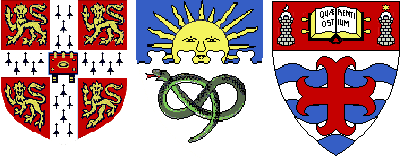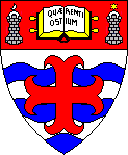What is heraldry and why might it interest me?
Heraldry is the study of things like this:

These are coats of arms and can be described precisely – but no more precisely than necessary – in a language called blazon. People have coats of arms and organisations have coats of arms. Different members of a family have coats of arms which are based on that of the head of the family but “differenced” in some way by the addition of extra symbols. Different branches use variants of the main coat of arms in which, perhaps, the colours have been re-arranged.
Heraldry has many different aspects:
- Historical – Obviously… heraldry has been around for about 700 years.
- Genealogical – Coats of arms are passed down from one head of a family to the next; relatives use variants. Heraldry can therefore give clues about hitherto unsuspected relationships between individuals.
- Antiquarian – Heraldry is found in churches, on memorials, portraits, silver, china, … It can often give a clue to the age of such items and the circumstances of manufacture. (An interesting novel with this as an integral part of the plot is The Nebuly Coat by J. Meade Faulkner.)
- Art and Design – As noted above, a coat of arms is specified by its description only. Therefore, different artists can interpret the same coat of arms in very different ways. This is particularly obvious when making comparisons over long periods of time. In this respect, heraldry should be compared and contrasted with the modern practice of using “logos”. Anyone who has ever had anything to do with logos knows that every single aspect of these (size, aspect ratio, colour, occasions for use …) is defined rigidly and can never be altered. Heraldry is a living art; logos constitute a sterile one.
- Scientific – Heraldry has its own language with a well defined syntax. Scientists often find this fascinating – so much so that pieces of software have been written to interpret a written blazon or to translate the blazon between different languages.
In practice, these aspects are so closely interconnected that many people see that as another attraction in its own right.
The Society has a good library of heraldic texts so if you would like to find out more about heraldry but don’t want to buy a book it is far cheaper to join the Society and take advantage of its library.
Examples of coats of arms
University of Cambridge

The arms of the University of Cambridge granted in 1573 by Robert Cooke, Clarenceux King of Arms and a graduate of St. John’s College.
The blazon is:
“Gules, a cross ermine between four lions passant gardant or, and on the cross a closed book fessways gules clasped and garnished gold, the clasps downward”
The original blazon read: “Gules sur ung croix dermines entre quatre Lions passant d'or Livre de gules”
The blazon means:
On a red background (gules), a white cross with black ermine tails (ermine) between four yellow (or) lions walking but with one leg raised (passant) and facing the observer (gardant). On the centre of the cross is a closed red (gules) book with its spine horizontal (fessways) with gold clasps and decoration and the clasps pointing down.
Victoria University of Manchester

The arms of the Victoria University of Manchester (founded 1880). Arms granted to its predecessor, Owen’s College, Manchester on October 14th, 1871.
The blazon is:
“Argent, a serpent nowed vert, on a chief nebulee azure, a sun issuant or.”
The blazon means:
The shield is white (argent) and shows a green (vert) snake (serpent) in the form of a knot (nowed). The top third (chief) is blue (azure) and separated from the rest of the shield by a line which has cloud-shaped waves in it (nebulee). On this top third is a yellow (or) sun emerging from the dividing line (issuant).
University of Nottingham

The arms of the University of Nottingham (founded 1948) granted to University College, Nottingham in 1904 and confirmed in 1948.
The blazon is:
“Barry wavy of six argent and azure, a cross moline gules; on a chief of the last an open book proper clasped or inscribed with the words ‘Quaerenti Ostium’ in Roman characters sable between two domed towers also proper, that to the dexter ensigned with an increscent of the first and that to the sinister with an estoile also or.”
The blazon means:
The shield has six horizontal lines (barry) alternatively white (argent) and blue (azure) and which are wavy. On them is a red (gules) cross of which the arms don’t reach the edge of the shield but which are flared in a certain conventional manner (moline). Above the main part of the shield is a red (gules) horizontal stripe (chief) on which are a book showing the words Quaerenti ostium between two capped towers in their natural colours (proper); above the right (dexter) [to someone standing behind the shield] one is a white (argent) crescent and the above the left is a yellow (or) star with six rays.
